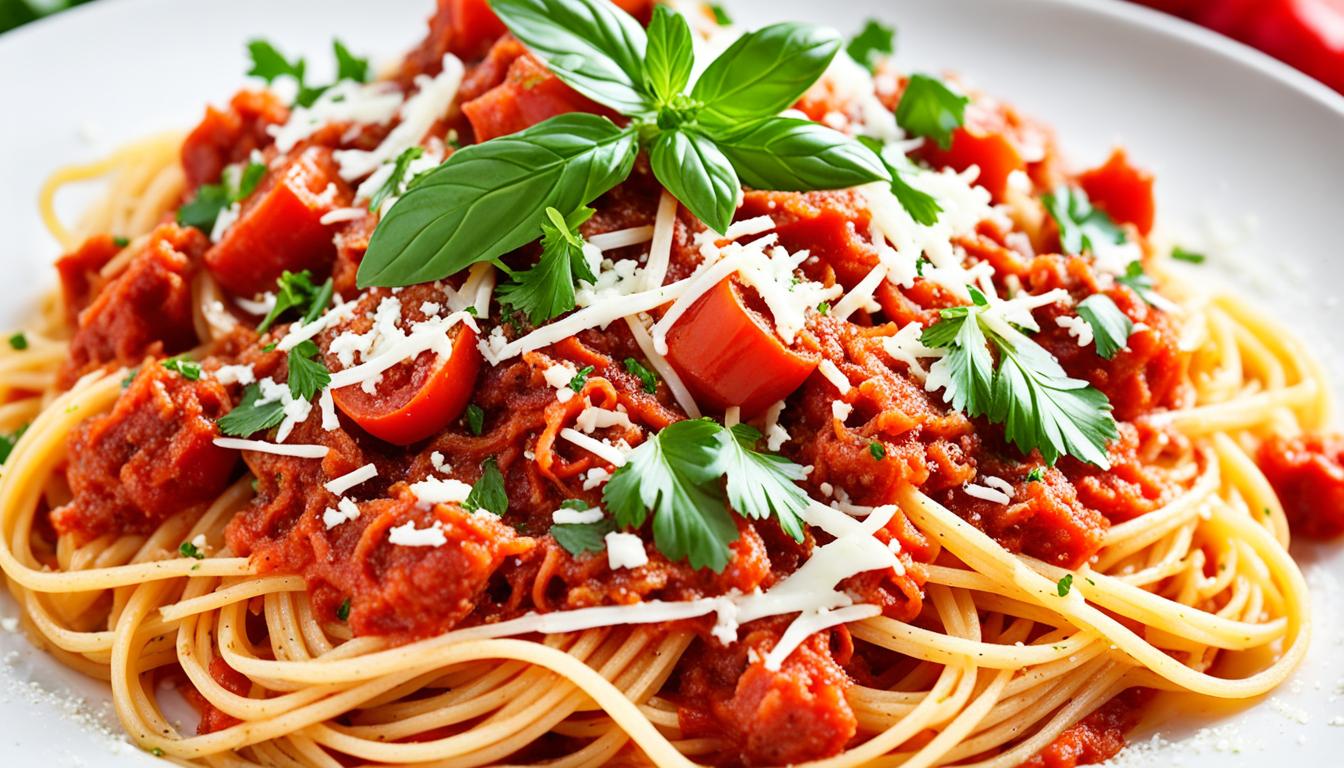Are you craving a taste of authentic Sicilian cuisine? Look no further than this mouthwatering recipe for Sicilian Style Spaghetti Alla Carrettiera. But what makes this pasta dish truly special? It’s all in the fresh tomato and garlic sauce that clings to every strand of spaghetti, creating a burst of flavor with each bite. Say goodbye to boring, store-bought sauces and experience the true essence of homemade Italian cooking.
The History and Origins of Spaghetti Alla Carrettiera
The origins of Spaghetti Alla Carrettiera can be traced back to the cart drivers in Sicily who traveled from town to town selling goods. These cart drivers needed to create simple and easy pasta dishes using the ingredients they carried in their carts. The recipe developed based on the region they traveled to, with variations in the ingredients used. In Sicily, fresh tomatoes were abundant, leading to the use of grated fresh tomatoes in the sauce. In other regions, canned tomatoes and shelf-stable ingredients like canned tuna and dried porcini mushrooms were used. The name “carrettiera” refers to the cart drivers themselves, who were known for their ingenuity and resourcefulness in creating flavorful pasta dishes on the go.
Spaghetti Alla Carrettiera owes its roots to the ingenuity and resourcefulness of Sicilian cart drivers. These drivers, who traversed various regions in Sicily, needed to create simple and delicious pasta dishes using the limited ingredients they carried in their carts. The recipe for Spaghetti Alla Carrettiera took shape based on the ingredients available in each region they traveled to, resulting in unique variations of the dish.
In Sicily, fresh tomatoes were abundant, and the cart drivers made use of this ingredient by grating fresh tomatoes to create a flavorful sauce for the spaghetti. Combined with minced garlic, olive oil, and a touch of red pepper flakes, the sauce provided a burst of flavors that perfectly complemented the pasta. The grated tomatoes, when cooked with the spaghetti and some of its starchy water, formed a delectable emulsified dish wherein the sauce clung to every strand of pasta.
In other regions, such as in areas where fresh tomatoes were not as readily available, cart drivers utilized canned tomatoes and other shelf-stable ingredients like canned tuna or dried porcini mushrooms to create their rendition of Spaghetti Alla Carrettiera. Despite the variations in ingredients, the essence of the dish remained the same – a comforting and satisfying pasta dish that showcased the resourcefulness of the cart drivers.
The name “carrettiera” pays homage to these innovative cart drivers, highlighting their ability to create mouthwatering pasta dishes on the go using whatever ingredients they had on hand. Spaghetti Alla Carrettiera exemplifies the simplicity and authenticity of Sicilian cuisine, making it a beloved traditional Italian pasta dish that continues to be enjoyed by pasta lovers around the world.
How to Make Sicilian Style Spaghetti Alla Carrettiera
Making Sicilian Style Spaghetti Alla Carrettiera is a quick and easy process that will leave you with a flavorful and satisfying dish. Follow these steps to recreate this authentic Italian recipe:
- Prepare the Sauce: Start by grating fresh tomatoes on the largest holes of a box grater until only the skin remains. In a bowl, add the grated tomatoes, olive oil, chopped basil, minced garlic, red pepper flakes, and a pinch of salt. Set the sauce aside to let the flavors meld together.
- Cook the Spaghetti: Bring a pot of lightly salted water to a boil. Add the spaghetti and cook until al dente, following the package instructions. It’s important to cook the pasta just right for the perfect texture.
- Create an Emulsion: Just before the spaghetti finishes cooking, take a ladle of the pasta cooking water and add it to the tomato mixture. Whisk vigorously to form an emulsion, combining the flavors of the tomatoes and creating a creamy sauce.
- Toss and Stir: Using tongs, transfer the cooked spaghetti to the tomato mixture, along with some additional pasta cooking water. Toss and stir vigorously to coat the noodles evenly with the sauce and create an emulsified texture.
- Add the Finishing Touches: Sprinkle toasted breadcrumbs over the spaghetti and continue to toss to combine. This will add a delightful crunch and depth of flavor to the dish.
The result should be a mouthwatering plate of Sicilian Style Spaghetti Alla Carrettiera, with each strand of pasta coated in a creamy, emulsified sauce. If the consistency of the sauce needs adjustment, simply add more pasta water or olive oil. Finally, garnish with breadcrumbs and, for an extra touch of authenticity, grate some Sicilian Pecorino or ricotta salata on top.
Now that you know the secrets behind this easy spaghetti alla carrettiera recipe, you can indulge in the flavors of Sicilian cuisine right in your own kitchen.
Variations and Tips for Sicilian Style Spaghetti Alla Carrettiera
Sicilian Style Spaghetti Alla Carrettiera is a versatile dish that allows for endless variations and customization according to your preferences and the ingredients you have on hand. While the traditional recipe calls for fresh basil, you can easily substitute it with fresh parsley for a different flavor profile. If you don’t have fresh tomatoes, you can make an in bianco (“white”) version of the sauce without them.
For a more traditional sauce, you can prepare it with tomato sauce or peeled tomatoes that have been browned in a pan with garlic and chili. This will give the sauce a richer and bolder flavor. Another option to enhance the taste of the dish is by adding tuna, particularly tuna belly, which brings a delightful umami element to the pasta.
To achieve a creamier texture in the sauce, vigorously stir and emulsify the ingredients. You can also reserve some pasta water to add to the sauce, creating a silky and creamy consistency. And don’t forget the final touch – drizzle some extra olive oil on top of the pasta before serving. This will not only enhance the flavors but also add a luscious sheen to the dish.
